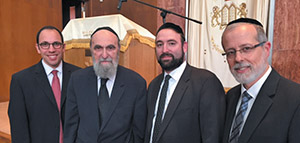
Designated by the Elizabeth community rabbonim, Sunday, September 20, marked the second annual all-community gathering during Aseret Yimei Teshuvah. The theme of this year’s event was “Torah, Avodah, and Gemilus Chasadim.” Each of the shul rabbis focused on one of these central themes, and then Rav Teitz tied the themes together as he addressed the kehilla with his closing remarks prior to a unified Minchah-Ma’ariv.
Rabbi Michael Bleicher opened with the well-known precept of the three principles on which the world stands: Torah, avodah, and gemilus chasadim. Since Torah preceded the creation of the world, the other two precepts are dependent on the Torah, because we derive our directives on how to carry them out from limud haTorah. Not only do we get our directives from the Torah, but since any person of any (or no) religious stripe can pray or practice kindness, we see how the Torah’s prescription makes avodah and gemilus chasadim uniquely Jewish. From the Torah we improve our insight into the Ratzon Hashem, and therefore the best and highest level of avodah and gemilus chasadim, including the best possible effect from our efforts. This process raises our awareness and perspective to practice these principles for their maximum quality and outcome.
The importance of limud haTorah is to “just do it.” Although there are myriad ways and schedules for learning, some people are unable to maintain a rigorous schedule, like the “Daf.” If that is true, don’t give up or despair. Find a pace and place that works for you, and persevere. It is this continuity of Torah learning that guarantees we will maintain our Mesorah going forward, for ourselves and all of klal Yisrael. The existence of the whole world depends on it.
Rabbi Avrohom Herman took the podium next, calling attention to Hashem’s bid for Tefillah even before Man was created. Rabbi Herman points out the Torah narrative that vegetation was created on the third day, but it remained in a state of suspension just at the surface. Only after the creation of Adam on the sixth day, when man could pray for rain, did the vegetation grow. Thus, we have our paradigm for the power and necessity of tefillah. According to Rav Elya Lopian, Hashem wanted man to have a continual connection to the Ribbono Shel Olam, and therefore tefillah was needed for everything. Further, a person should never despair or give up on the salvation of Hashem, as he pointed out via the Navi the poignant story of King Chizkiyahu on his deathbed. Chizkiyahu learned from his ancestor David Hamelech not to hold back from asking rachamim of Hashem; and that a person has to daven as if his life depends on it (and it does!). We daven especially during this time of year that Hashem should answer us with what is best for us and all of klal Yisrael. And all tefillos are answered; if not now, then they are “banked” by Hashem for a future benefit.
Rabbi Jonathan Schwartz followed, opening with the post-Churban remark of the great Yochanan ben Zakai not to despair of the destruction, because a system of atonement yet remained with the nation of Israel. Gemilus chasadim has the capacity to replace the Avodah of the lost Beis Hamikdash. We know this, said Rabbi Schwartz, because of the principle of “Chesed Yiboneh,” kindness is a builder. He continued with the idea that there are two manifestations of chesed: doing and being. The average responsible person is kind as a natural human desire. The Torah Jew is a “being” of chesed, a gomel chesed motivated by a desire to emulate this middah of Hashem. It is a kindness that is not only kind, but also selfless, and because there is no agenda for a reward. One of our paradigms of this sort of kindness was when Rachel Immeinu relinquished to her sister Leah, indeed “stretching” herself in selfless kindness that endured both in her life and in her death. We see this chesed through the eyes of the Navi when Hashem gives ear to the cry of Rachel hundreds of years after her death in the time of the Churban. We strive to be not “ba’alei chesed,” but rather “gomlei chesed”—beings of chesed—in thought, mind and deed. This brand and love of chesed can be our conduit to Hashem and to connect with the Avodah lost with the Beis Hamikdash.
Rav Teitz tied things up by painting a vision of Torah, avodah, and gemilus chasodim as three columns of support. He noted that limud haTorah is a consequence of all of them. Avodah is not just davening, but leads us to reach for the truth of existence. Tzedakah brings peace between the givers and the recipients, reaping the ultimate goal of shalom and the Geulah. We can’t achieve the ultimate shalom with any of the two of these, but need to unite all three to make it work. Piska tovah!
By Ellie Wolf










